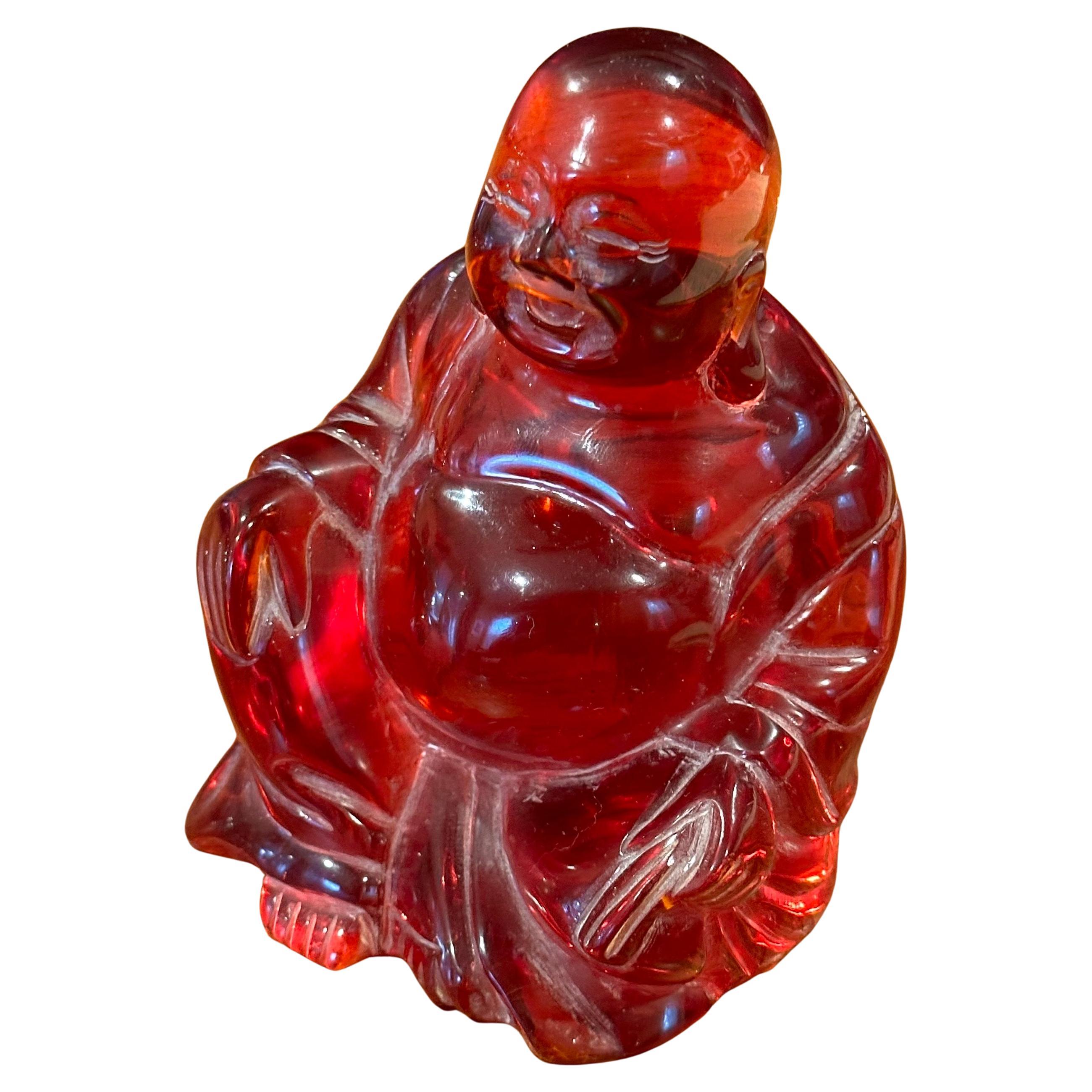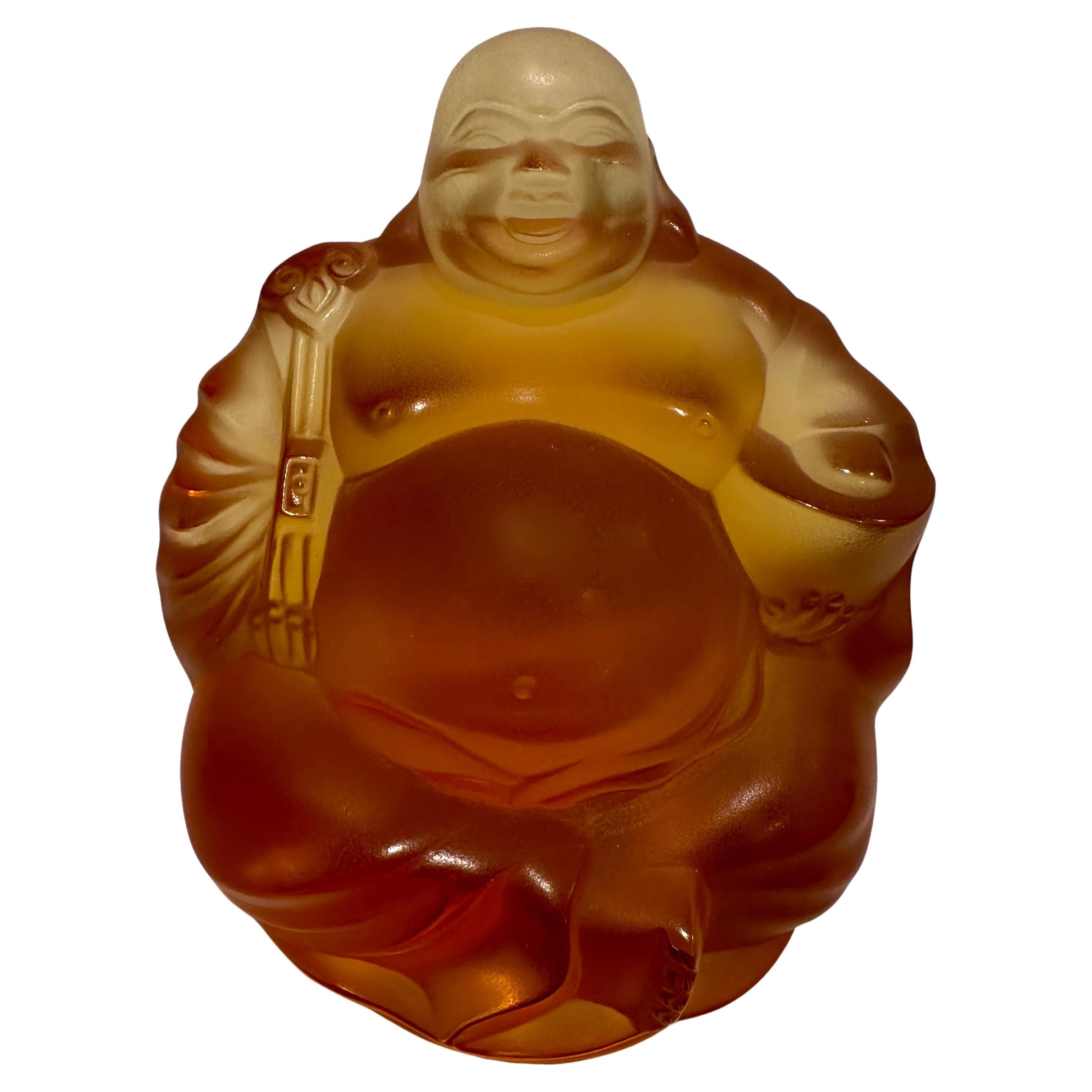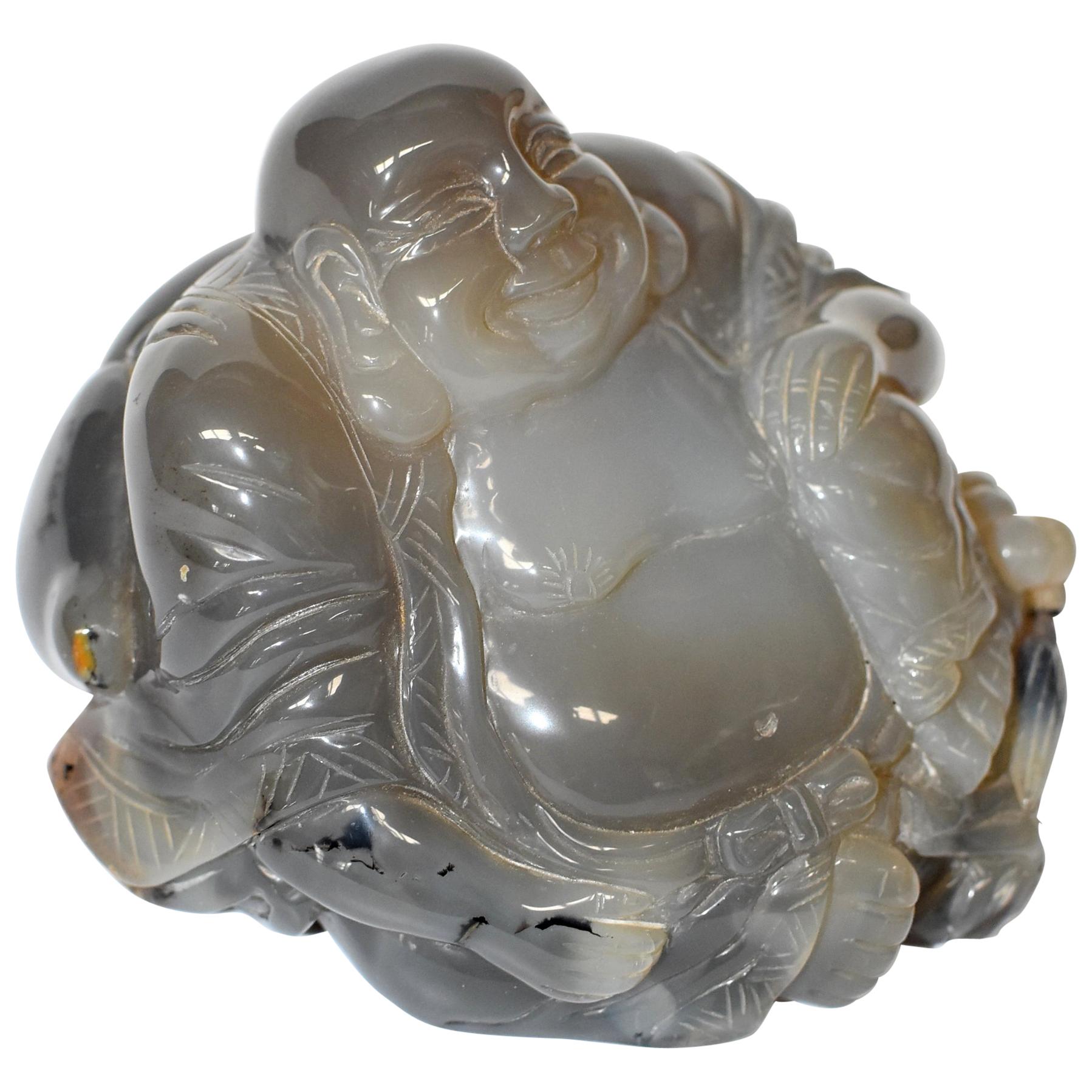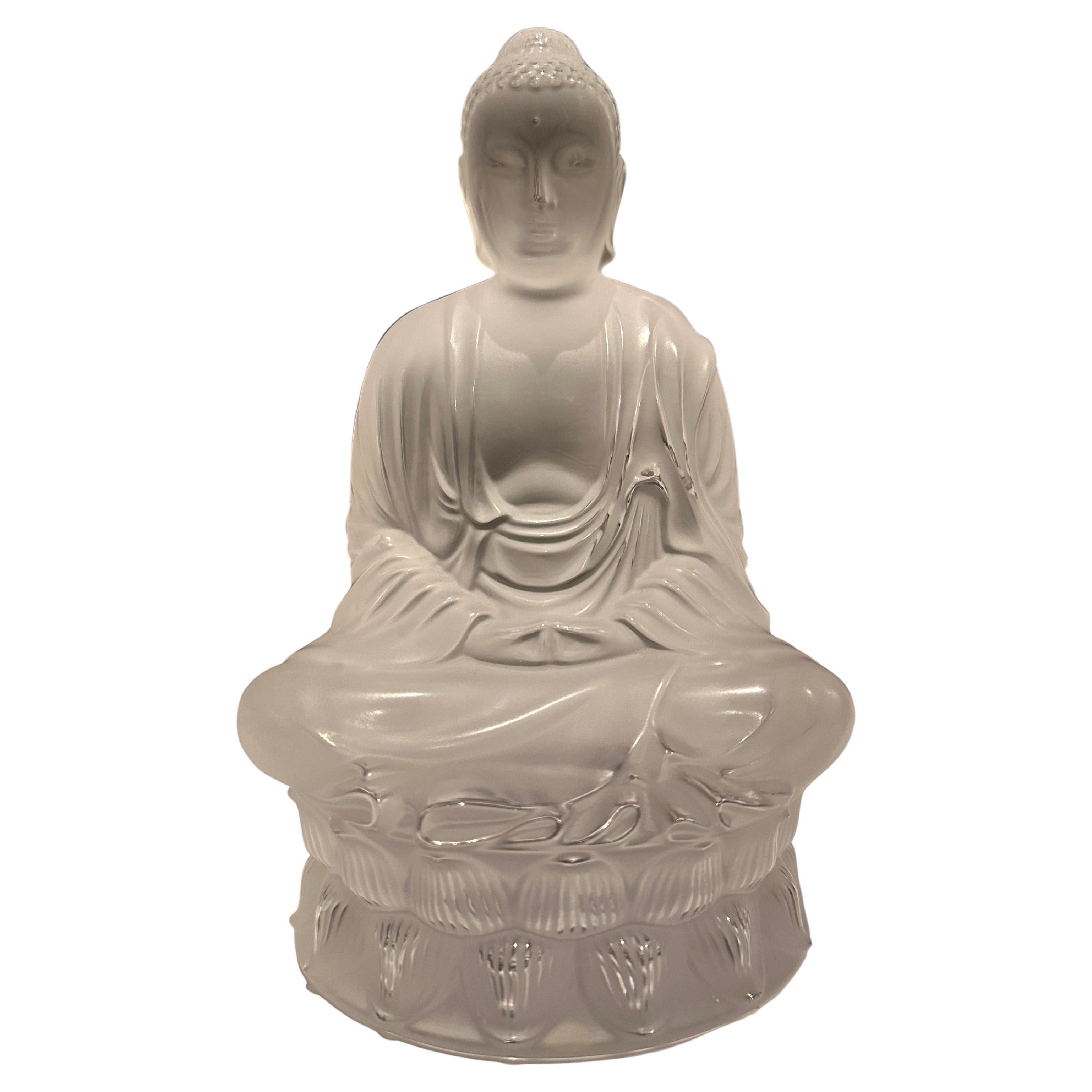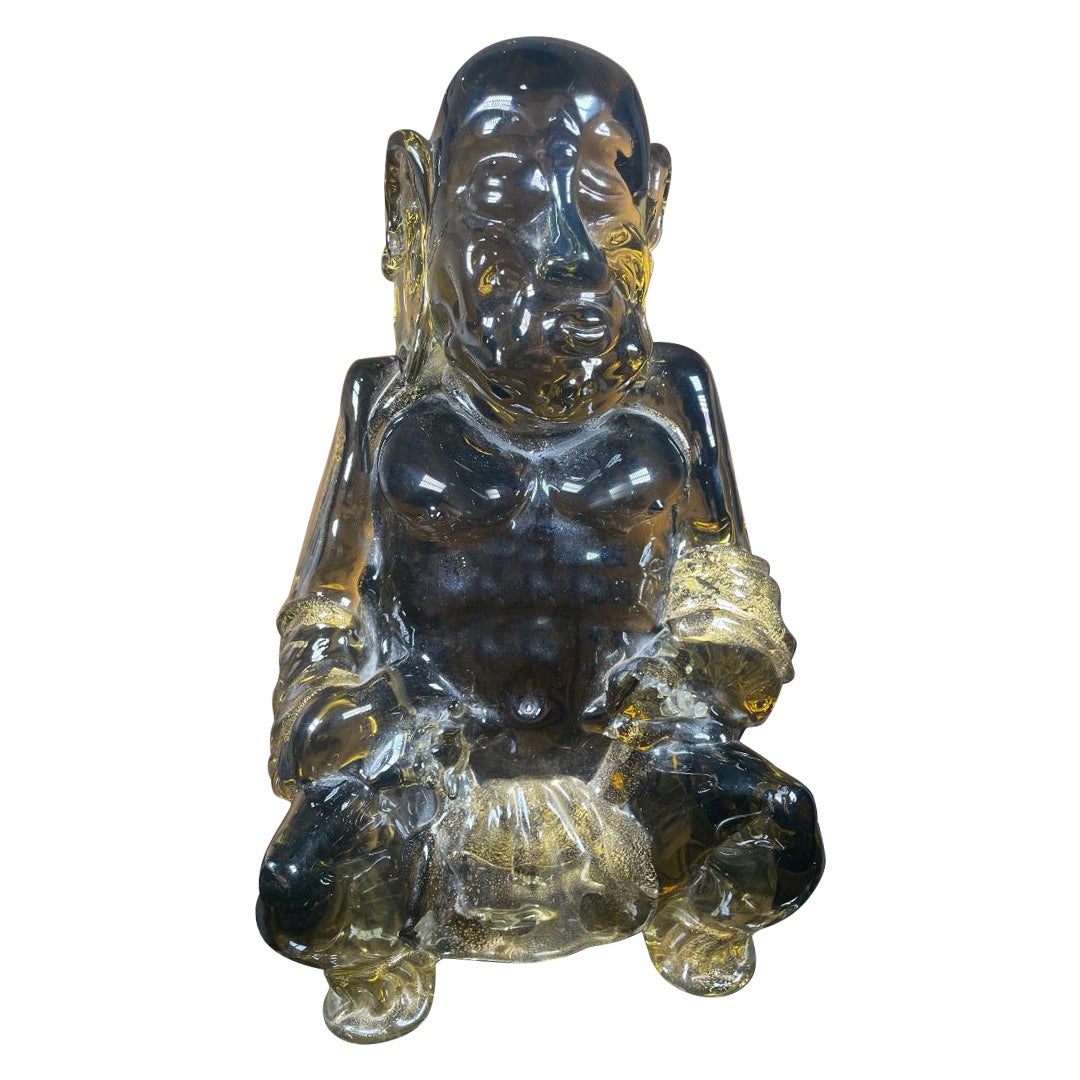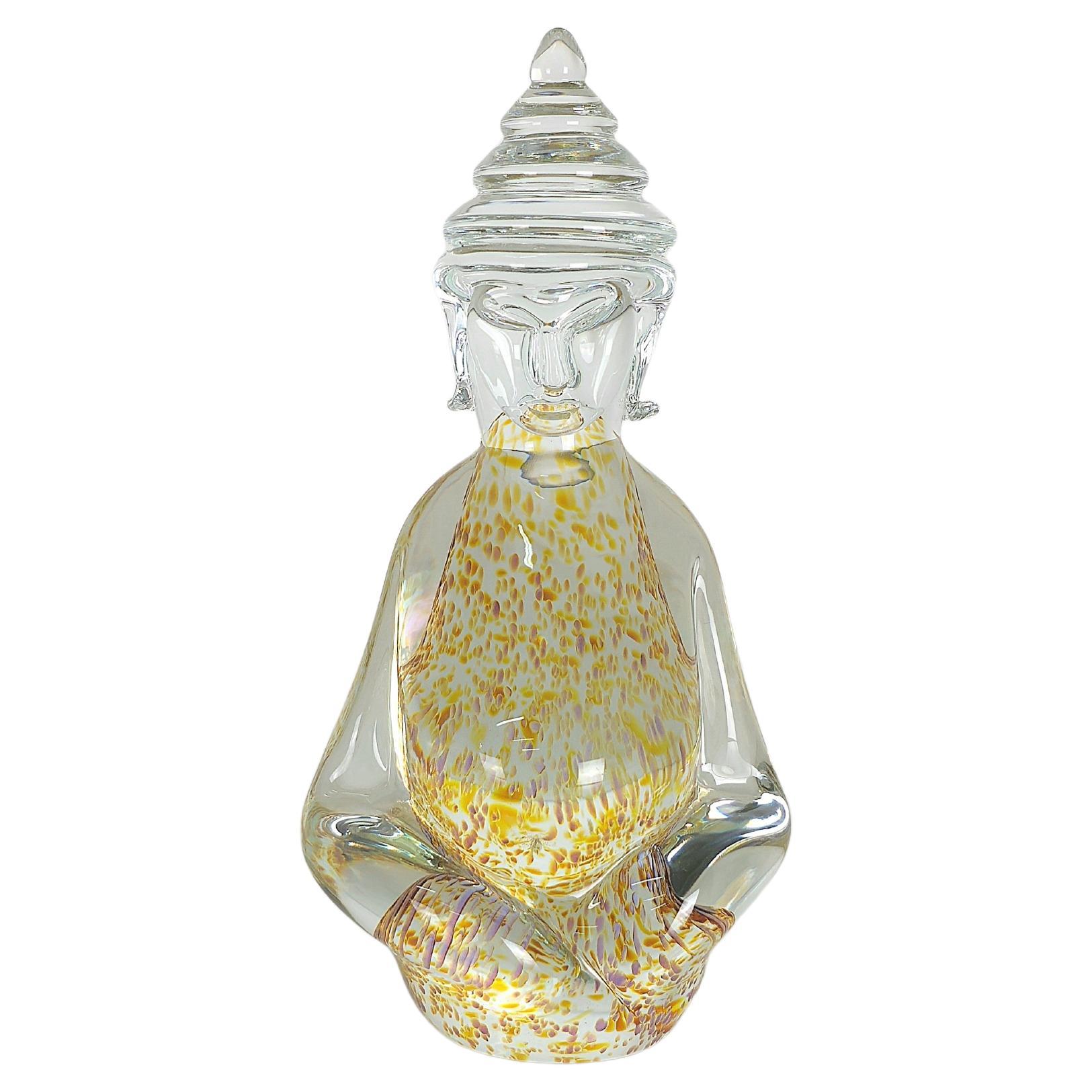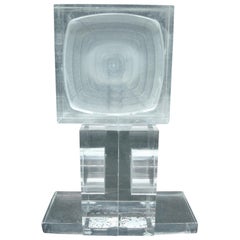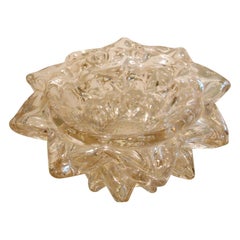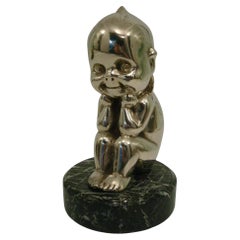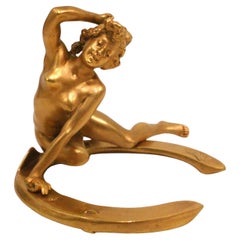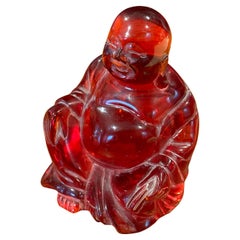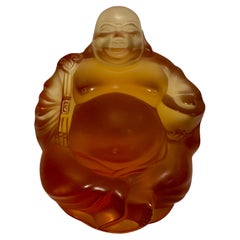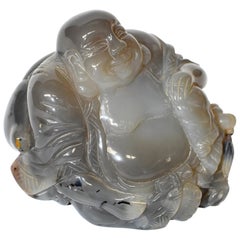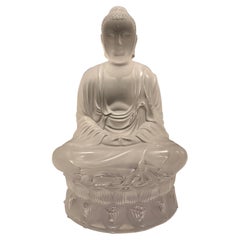Items Similar to Energetic Glass Buddha by Almeric Walter, Pate de Verre, France, 1900s
Want more images or videos?
Request additional images or videos from the seller
1 of 16
Energetic Glass Buddha by Almeric Walter, Pate de Verre, France, 1900s
$1,999
£1,483.34
€1,727.88
CA$2,782.62
A$3,098.70
CHF 1,612.70
MX$38,206.61
NOK 20,539
SEK 19,304.67
DKK 12,892.15
Shipping
Retrieving quote...The 1stDibs Promise:
Authenticity Guarantee,
Money-Back Guarantee,
24-Hour Cancellation
About the Item
Amalric Walter (français, 1870-1959)
A wonderful energetic Glass or Chrystal Shakyamuni Buddha by Almeric Walter from the Art Nouveau, Art Deco period circa 1920. These Buddha figures are rare as most Walter Pate de Verre models. Why copper or bronze when you can have glass.
Signed: A. WALTER NANCY and Bergé.
Victor Amalric Walter (19 May 1870 – 9 November 1959) was a French glass maker mainly known for his pâtes de verre pieces.
Born in Sèvres on 19 May 1870, Waltr first worked at the Manufacture nationale de Sèvres, near Paris, where he decorated and glazed earthenware pieces. He won a bronze award at the National and Colonial Fair of Rouen in 1896 and a gold award at the International Work Faire of Paris in 1901. He was impressed by the pâtes de verre of Albert Damousse, Decorchemont, Argy Rousseau and Henri Cros who received the Gold Medal of 1900 World's Fair.
He then decided to work for the Cristalleries Daum Nancy, France, from 1904 or 1905, where he stayed until the first World War in 1915. There, he met a designer/modelist, Henri Bergé, with whom he made pâtes de verre always signed "Daum Nancy", without his name nor Bergé's name. With his help, he cast around 100 different models; but few of these pieces from this period were preserved so far. He help decorating the living room of the Maison Losseau in 1911 with 15 pâte de verres representing the Belfry of Thuin and the river Sambre.
After the war, he decided to create his own glass studio at Nancy, rue Claudot. He continued his collaboration with Henri Bergé. From 1919-1935 with Bergé and other famous sculptors or designers, he cast not less than 500 models, always in few numbers due to the sophisticated technique of glass kiln casting. It is said that when he was not happy about pieces that came out from the kiln, he used to throw them onto the outside wall of his studio, saying he was a genuine perfectionist. His staff was not numerous (8-10 workers maximum).
Art Deco began to replace Art Nouveau, and Arts & Crafts production or small business sector became non-competitive due to high manufacturing costs. He then reoriented his production and cast simpler pieces, influenced by Art Deco design. Most of his pieces of the later period involve at most three colors, to reduce costs.
After 1935, Walter's workshop closed. He also progressively became blind. He died on 9 November 1959, blind and destitute, at Lury-sur-Arnon where he was visiting a friend.
Walter's work and glass casting process was neglected after his death. The Amalric Walter Research Project was launched in 2006 by Keith Cummings and Max Stewart in Dudley, England. At the same time an exhibition on Walter's pâtes de verre was held at the Broadfield House Glass Museum.
We have specialized in the sale of Art Deco and Art Nouveau and Vintage styles since 1995. If you have any questions we are at your disposal. Pushing the button that reads 'View All From Seller'. And you can see more objects to the style for sale. Why are there so many antiques in Argentina?
In the 1880 – 1940 there was a grate wave of immigration encouraged by the periods of war that were taking place. 1st World War took place between 1914 and 1918 2nd World War took place between 1939 and 1945 The immigrants options were New York or Buenos Aires. Tickets were cheap and in Buenos Aires they were welcomed with open arms, as it was a country where everything was still to be done. Argentina was the country of new opportunities, labour was needed and religious freedom was assured, in many cases the of the family travel first until they were settled and then the rest of the family members join them. In the immigrant museum “Ellis Island Immigrant Building” in New York you can se the promotional posters of the boats that would take them to a new life. Between the years 1895 and 1896, Argentina had the highest DGP (gross domestic product) per capita in the world according to the Maddison Historical Statistics index, this situation arose due to the large amount of food being exported to European countries, which were at war. The Argentinean ships left the port of Buenos Aires with food, but they returned with furniture, clothes and construction elements, (it´s common to see this the old buildings of the historic neighbourhood of San Telmo, the beams with the inscription “Made in England)”, as well as many markets that were built in Buenos Aires, such us the San Telmo Market, whose structure was brought by ship and afterwards assembled in 900 Defensa Street. With the great influence of European immigrants living in the country, the children of the upper classes travelled to study in France, resulting in the inauguration of “La Maison Argentinienne”, on 27th of June 1928, in the international city of Paris, which hosted many Argentinians that were studying in Frace. It´s the fourth house to be built after France, Canada and Belgium, being the first Spanish-speaking one. Still in place today (17 Bd Jourdan, 75014, Paris, France). Many of the children of these wealthy families who attended international art exhibitions, museums and art courses abroad, took a keen interest in the European style. This is why Buenos Aires was at the time referred as “The Paris of South America”. Between the years 1890 and 1920 more than a hundred Palaces were built on Alvear Avenue the most exclusive avenue in Buenos Aires. Today some of these palaces have been transformed into museums, hotels and embassies. In the year 1936, the Kavanagh building was inaugurated, it was the tallest reinforced concrete building in South America. During 1994 the American Society of Civil Engineers distinguished it as an “international engineering milestone”, and it´s now considered a World Heritage of Modern Architecture. At the time was common to hire foreign architects such as Le Corbusier, who visited Buenos Aires/Argentina in 1929 and in 1948 he drew up the blueprints for a house built in La Plata City (which was declared a World Heritage Site). In 1947, the Hungarian architect Marcelo Breuer designed “Parador Ariston” in the seaside city of Mar del Plata. After an Argentinean student at Harvard University convinced him to come to Argentina. He worked on an urban development project in the Casa Amarilla, area of La Boca. The Ukrainian architect, Vladimiro Acosta, arrives in Argentina in 1928 and worked as an architect until que moved to Brazil. Antonio Bonet, a Spanish architect who worked with Le Corbusier in Paris, arrives in Argentina in 1937, where he carried out several architectural works and in 1938 designs the well-known BFK chair. Andres Kálnay, of Hungarian origin, made around 120 architectural masterpieces, among which the former Munich brewery stands out, he even made the furniture’s design. The German architect, Walter Gropius, director of the Bauhaus, lived in Argentina, where he wrote articles for “Sur” magazine and founded in Buenos Aires, an architectural firm with Franz Möller, who was also an architect, where he built two houses. At the same time several famous designers decided to immigrate to Argentina, among them we can find the well-known French designer, Jean-Michel Frank, who arrived in the country in 1940 and also worked for the Rockefeller family. Special pieces were made, which were sold exclusively in the country, such as the well-known German company “WMF”, who sold their products by catalogue, which were chosen by the ladies of high society in the list of wedding gifts, as well as the pieces designed by Christofle. The Swiss sculptor Alberto Giacometti, made special pieces for Argentinean mansions. In 1904 the first Jansen branch outside Paris was established in Buenos Aires, as the Argentinean clientele demanded a large amount of furniture, from the end of the 19th century to the mid-20th century. In 1970, the brand Rigolleau Argentina made pieces authorised by Lalique. The brands Maple and Thompson also set up shop in the country. The French plastic artist, Marcel Duchamp moved to Argentina in 1918-1919. Glass signed Gallé, Charder, Leverre, Schneider, Muller and other French firms. They were bought in flower shops and were given to ladies with beautiful floral arrangements. Some furniture manufacturers travelled to international fairs and bough the patterns to produce the furniture in Argentina, such as the furniture firm Englander and Bonta, who bought the patterns in Italy. It is worth mentioning that in Argentina we have the largest community of Italians outside of Italy, as it is estimated that 70 percent of the inhabitants have at least one Italian descendant, followed by Spanish immigrants. The most Important furniture stores in Argentina: Comte is founded in 1934 (under the direct management of Jean Michel Frank in 1940). Nordiska (Swedish company established in 1934). Churba in 1960, a company that brought foreign designers to present their furniture in the country: Denmark: (Arne Jacobsen, Finn Juhl, Bender Madsen, Ejner Larsen, Poul Kjaerholm, Hans Wegner) Sweden: (Hans Agne Jakobsson, Gustavsberg) United States: (Herman Miller) Finland: (Lisa Johansson, Folke Arstrom, Tapio Wirkkala, Alvar Aalto, Timo Sarpaneva) Swedish Factory: (Orrefors) Italy: (Littala, Vico Magistretti, Emma Gismondi, Gae Aulenti, Angelo Mangiarotti, Elio Martinelli, Gianna Celada, Angelo Mangiarotti, Mario Bellini, Carlo Scarpa) Finland: (Olivia Toikka) Plata Lappas (Lappas Silver): a goldsmith shop founded in 1887 in Argentina by Alcibiades Lappas of Greek origin. In 2019, in Argentina took place “the Art Deco world congress” . Argentina currently has more than 100 Art Deco buildings and another 90 Art Nouveau buildings throughout the city of Buenos Aires. Argentina is a country that has not been involved in many wars, which is why it has been a refuge for works of art and antiques from different periods of time, unlike European countries. That is way many collectors, museums and antique dealers from all over the world visit it, you should not miss the opportunity to visit this great country.
- Creator:A. Walter Nancy (Artist)
- Dimensions:Height: 3.55 in (9 cm)Width: 3.15 in (8 cm)Depth: 2.37 in (6 cm)
- Style:Art Nouveau (Of the Period)
- Materials and Techniques:
- Place of Origin:
- Period:
- Date of Manufacture:1900-1920
- Condition:Wear consistent with age and use.
- Seller Location:Buenos Aires, AR
- Reference Number:1stDibs: LU2027314613541
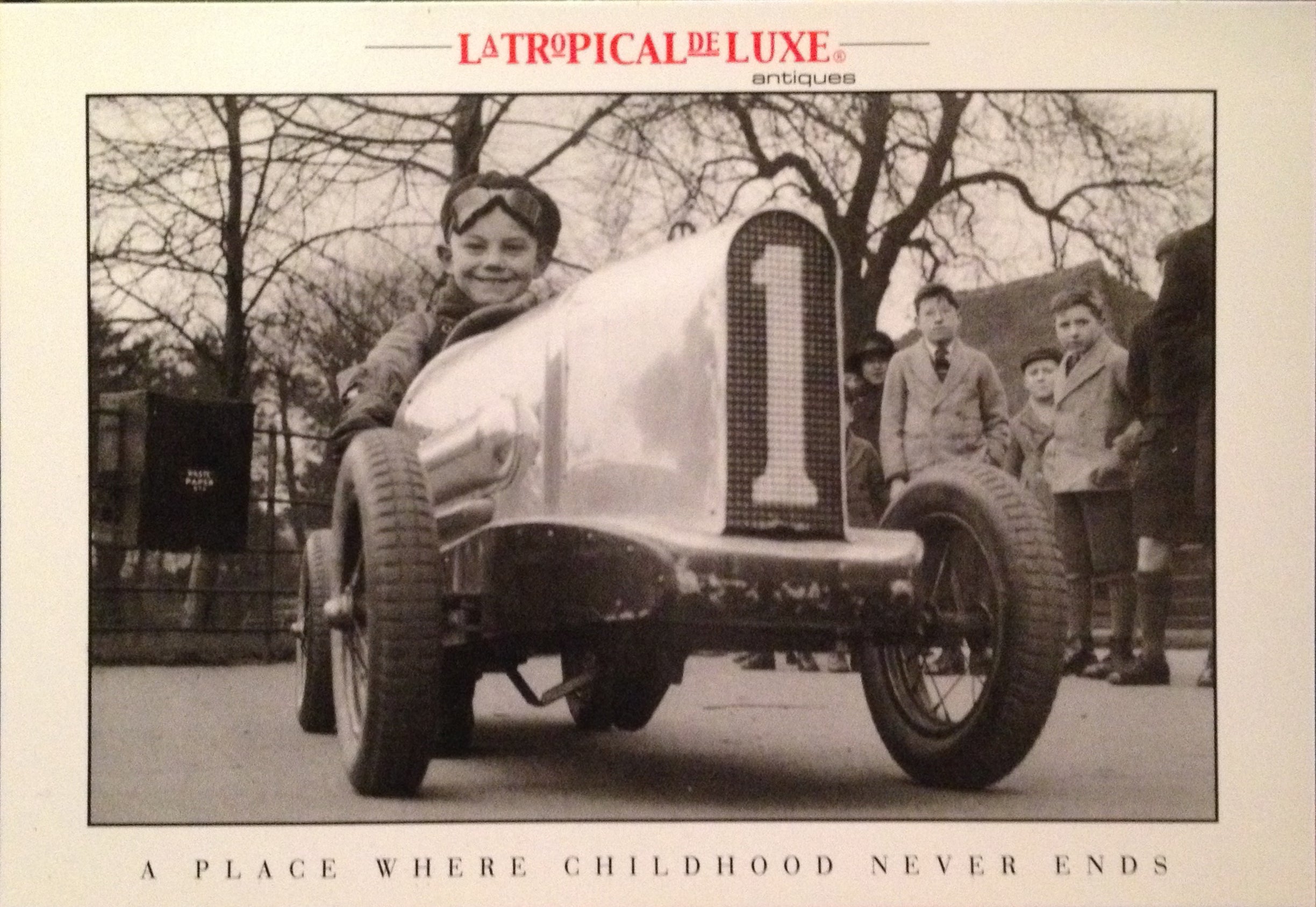
About the Seller
4.9
Vetted Professional Seller
Every seller passes strict standards for authenticity and reliability
Established in 2002
1stDibs seller since 2016
319 sales on 1stDibs
Typical response time: 1 hour
- ShippingRetrieving quote...Shipping from: Buenos Aires, Argentina
- Return Policy
Authenticity Guarantee
In the unlikely event there’s an issue with an item’s authenticity, contact us within 1 year for a full refund. DetailsMoney-Back Guarantee
If your item is not as described, is damaged in transit, or does not arrive, contact us within 7 days for a full refund. Details24-Hour Cancellation
You have a 24-hour grace period in which to reconsider your purchase, with no questions asked.Vetted Professional Sellers
Our world-class sellers must adhere to strict standards for service and quality, maintaining the integrity of our listings.Price-Match Guarantee
If you find that a seller listed the same item for a lower price elsewhere, we’ll match it.Trusted Global Delivery
Our best-in-class carrier network provides specialized shipping options worldwide, including custom delivery.More From This Seller
View AllMid Century / Modern - Acrylic / Lucite Sculpture Abstract, 1960s
Located in Buenos Aires, Olivos
Mid Century / Modern - Acrylic / Lucite Sculpture Abstract, 1960s
We have specialized in the sale of Art Deco and Art Nouveau and Vintage styles since 1995. If you have any questio...
Category
Late 20th Century American Mid-Century Modern Abstract Sculptures
Materials
Acrylic
Barovier Toso Italian Vintage Art Glass Rostrato Murano Vase / Bowl, circa 1938
By Ercole Barovier, Ferro Toso Barovier
Located in Buenos Aires, Olivos
Barovier Toso Italian vintage art glass Rostrato Murano vase / bowl, circa 1938
An exquisite mid-20th century centrepiece by Barovier & Toso in b...
Category
Mid-20th Century Italian Mid-Century Modern Glass
Materials
Murano Glass
$1,760 Sale Price
20% Off
Sitting Kewpie or The Thinker, Silvered Bronze Car Mascot Hood Ornament, 1910´s
Located in Buenos Aires, Olivos
"Sitting Kewpie" or "The Thinker", Car Mascot Hood Ornament, 1910´s.
Made of silvered bronze, mounted over a green and white mrble base.
Can de used as a desk paperweight.
Originally appearing in the form of magazine illustrations between 1905 and 1909, Kewpie dolls...
Category
Early 20th Century American Art Nouveau Figurative Sculptures
Materials
Marble, Bronze
Georges Récipon, "Lucky", Gilt Patina Bronze Sculpture / Desk Paperweight
By Georges Récipon, Susse Freres
Located in Buenos Aires, Olivos
Georges Récipon, "Lucky", Gilt Patina Bronze Sculpture / Desk Paperweight. Signed and dated.
Beautiful bronze sculpture (gold patina) representing a naked woman nailed a horseshoe, ...
Category
Antique 1890s French Art Nouveau Figurative Sculptures
Materials
Bronze
Art Deco Elephant Paperweight. Retailed by Asprey - London 1930´s
By Asprey International Limited
Located in Buenos Aires, Olivos
Art Deco Pewter Elephant Paperweight. Retailed by Asprey - London 1930´s
Small statue of an elephant standing on its hind legs with its trunk raised. T...
Category
Mid-20th Century British Art Deco Animal Sculptures
Materials
Marble, Metal
Nude Car Mascot / Hood Ornament, by Antoine Bofill, French, Circa 1920
By Antoine Bofill
Located in Buenos Aires, Olivos
Nude comparison car mascot / hood ornament, by Antoine Bofill, French, Circa 1920
Signed 'Bofill' to top of base and with foundry stamp 'R.Patrouilleau Edit_Paris' around the base, ...
Category
Early 20th Century French Art Deco Figurative Sculptures
Materials
Marble, Bronze
$3,299 Sale Price
26% Off
You May Also Like
Vintage Amber Lucite "Happy Buddha" Sculpture
Located in San Diego, CA
A vintage amber lucite "Happy Buddha" sculpture, circa 1970s. The piece is in very good vintage condition and measures 3.5"W x 3"D x 4.5"H. A laughing or happy Buddha is the ultimate...
Category
Mid-20th Century American Figurative Sculptures
Materials
Resin
Lalique Amber Crystal Model of a Seated "Happy Buddha"
By Lalique
Located in Norwood, NJ
A Lalique limited edition amber glass model of a seated 'Happy Buddha', numbered 809/888.
Category
21st Century and Contemporary French Modern Figurative Sculptures
Materials
Crystal
$731 Sale Price
25% Off
Agate Happy Buddha 3 lb
Located in Somis, CA
A hand-carved, solid agate Buddha. He is depicted sitting with his robe open, cinched with a bow under his belly, an expression for great allowance. The h...
Category
20th Century Chinese Sculptures and Carvings
Materials
Agate
$1,504 Sale Price
20% Off
Lalique Clear Frosted Crystal Buddha
By Lalique
Located in Norwood, NJ
A stunning rendition of the sage on whose teachings Buddhism was founded. The Buddha meditates solemnly in this Fine mouth-blown and hand carved crystal sculpture...
Category
21st Century and Contemporary French Modern Figurative Sculptures
Materials
Crystal
$1,031 Sale Price
25% Off
Italy Impressive Murano Gold Hand blown Glass Meditation Buddha, Signed
Located in South Burlington, VT
Unique one-of-a-kind meditaton buddha
From Italy and Murano comes this charming large scale, solid hand blown glass seated Meditating Buddha
It is a rare one-of-a-kind sculpture executed in amber color with gold flecking and high lights by maestro Giancarlo Signoretto.
Signature: signed on the front base Giancarlo Signoretto, about 1985
Dimensions: 15 inches high
Provenance: Veneto, Italy forty year old family collection.
Photographs taken both inside our gallery and outside in natural light for your viewing pleasure.
This is a one-of-a-kind treasure and would make a spectacular acquisition for the discerning connoisseur of artistic delights or a very special meditation room...
Category
Mid-20th Century Italian Figurative Sculptures
Materials
Glass
$1,200 Sale Price
82% Off
Decorative Object Sculpture Murano Glass Buddha Midcentury Italian Design 1970s
Located in Palermo, IT
Sculpture/decorative object of a buddha made of transparent Murano glass and aventurine. produced in Italy in the 70s. Please watch the video and photos carefully, thank you.
Weight...
Category
Mid-20th Century Italian Mid-Century Modern Figurative Sculptures
Materials
Murano Glass
More Ways To Browse
French Gold Religious Medals
2006 Herman Miller
Sevres Pate Sur Pate
Antique Mezuzah
Art Deco Wall Crucifix
Austrian Menorah
Christ Pantocrator
Mexican Crucifix
Moroccan Menorah
Spanish Colonial Crucifix
Virgin Santos
19th Century Wooden Crucifix
Bronze Jesus Plaque
Coptic Cross
Esther Scroll
Havdalah Spice Box
Jerusalem Mother Of Pearl
Lion Skull
